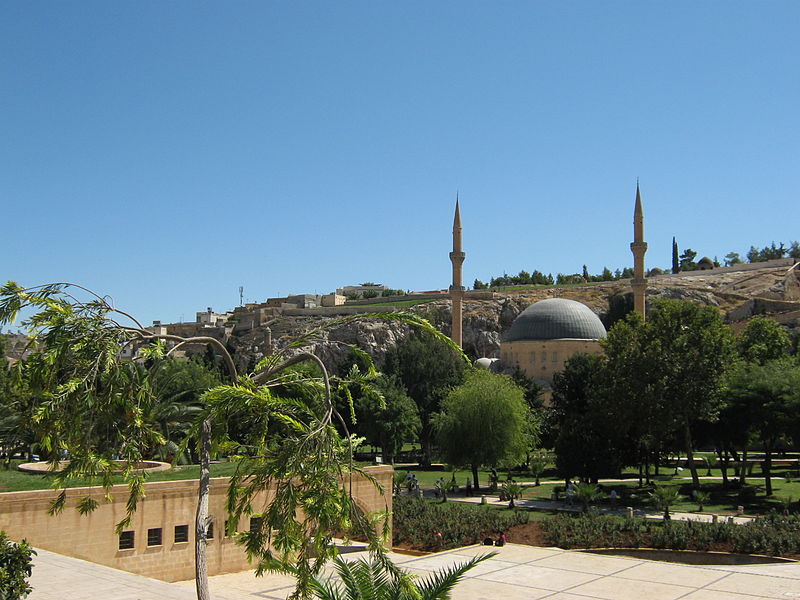
There are many traditions regarding the location of Ur Chasdim including Islam and the classical writer Eusebius.
According to Islamic tradition, the birthplace of Abraham – Ur Chasdim – is location not in Mesopotamia but in southern Turkey. Islamic tradition places Ur Chasdim in the ancient city of Edessa (now known as Sanliufra or simply as Urfa).1
In 1848 J.J. Benjamin II visited the town of Urfa and wrote about his travels there in his book Eight years in Asia and Africa.
“Eighteen hours’ journey from Birdschak lies, in a desert neighbourhood, the town of Urfa, likewise enclosed by a wall. Round about the town are to be found a great number of grottoes, built by human hand; these are all open, and lead into a subterranean passage, which is said to be several hours’ journey in length. Regular gates, doors, streets, extensive places and even wells are to be found here. It is beyond all doubt that these are the traces of a town destroyed by an earthquake. Could it not be the ancient “Ur” of the Chaldees, of which Moses speaks? *
In Urfa are to be found monuments of antiquity, which date from the oldest biblical times; some are preserved up to this day; others are lying in ruins. We mention here some of the most remarkable:
1) The house, in which Abraham was born. It is an artificial grotto, hewn out of a single piece of rock; and a cradle of white stone. The grotto is closed and guarded by the Arabs; one can however enter it on payment of a small gratuity. The Arabs are wont to carry thither their sick children, and to lay them in Abraham’s cradle, in which they leave the little ones for the whole night; if they are not found dead the next morning, their recovery can be looked forward to with safety.”2
Eusebius wrote about the city of Ur Chasdim in his book Preparation for the Gospel. Eusebius preserves a portion of Alexander Polyhistor’s work Concerning the Jews which in turn quotes from the historian Eupolemus’ work Concerning the Jewish of Assyria.
“CHAPTER XVII
AND with this agrees also Alexander Polyhistor, a man of great intellect and much learning, and very well known to those Greeks who have gathered the fruits of education in no perfunctory manner: for in his compilation, Concerning the Jews, he records the history of this man Abraham in the following manner word for word:
[ALEXANDER POLYHISTOR] ‘Eupolemus in his book Concerning the Jews of Assyria says that the city Babylon was first founded by those who escaped from the Deluge; and that they were giants, and built the tower renowned in history.
‘But when this had been overthrown by the act of God, the giants were dispersed over the whole earth. And in the tenth generation, he says, in Camarina a city of Babylonia, which some call the city Uria (and which is by interpretation the city of the Chaldees), + in the thirteenth generation + Abraham was born, who surpassed all men in nobility and wisdom, who was also the inventor of astronomy and the Chaldaic art, and pleased God well by his zeal towards religion.”3
Bereishit יא (Genesis 11)
31 And Terah took Abram his son, and Lot the son of Haran, his son’s son, and Sarai his daughter-in-law, his son Abram’s wife; and they went forth with them from Ur of the Chaldees, to go into the land of Canaan; and they came unto Haran, and dwelt there. 32 And the days of Terah were two hundred and five years; and Terah died in Haran.
Haran was the city, according to the Torah, where Abram and his family journeyed when they left Ur Chasdim on their way to Canaan. It was in this place that Abram’s father Terah died. When Abram was 75 years old, Abram, Sarai, Lot, their extended family and servants left Haran to continue onto Canaan. There is an indication later in Bereishit (27:42-43) that some of Abram’s relatives remained in Haran.
Biblical Haran is identified by scholars with the city Harran in modern-day Turkey. This city was the chief home of the Mesopotamian god Sin and remained the chief city of the pagan god under the Assyrians, Chaldeans, and Romans.4 According to the Christian apocryphal work The Book of the Cave of Treasures, Nimrod is credited with founding the city of Harran.
And in the fiftieth year of [the life of] Reu, Nimrod went up and built Nisibis, and Edessa, and Harrân, which is Edessa. And Harrânîth, the wife of Dâsân, the priest of the mountain, surrounded it with a wall, and the people of Harrân made a statue of her and worshipped her. And Baltîn, who was given to Tamûzâ (Tammuz)–now because B`êlshemîn loved her, Tammuz fled before him–set fire to Harrân and burned it. (The Book of the Cave of Treasures – The Fourth Thousand Years)5
The death and burial of Abram’s father Terah in Harran is also mentioned in the Arabic work Kitab al-Magall.
When Terah, father of Abraham, reached two hundred and three years he died. Abraham and Lot buried him in the city of Haran. [God] commanded him that he should travel to the Holy Land.6
———————————–
1Wikipedia. Ur Kasdim. [http://en.wikipedia.org/wiki/Ur_Ka%C5%9Bdim#Islamic_tradition]
2Benjamin, J. Eight Years in Asia and Africa From 1846 to 1855. (Hanover, 1859).
3Gifford, E. H. Eusebius of Caesarea: Praeparatio Evangelica. (1903). [http://www.tertullian.org/fathers/eusebius_pe_09_book9.htm]
4“Harran.” britannica.com. Encyclopedia Britannica. n.d. Web. 23 October 2011. [http://www.britannica.com/EBchecked/topic/255841/Harran]
5Budge, E. A. W. The Book of the Cave of Treasures. (London: The Religious Tract Society, 1927).
6Gibson, M. D. “Kitab al-Magall or The Book of Rolls” Apocrypha Arabica. (London, 1901).
